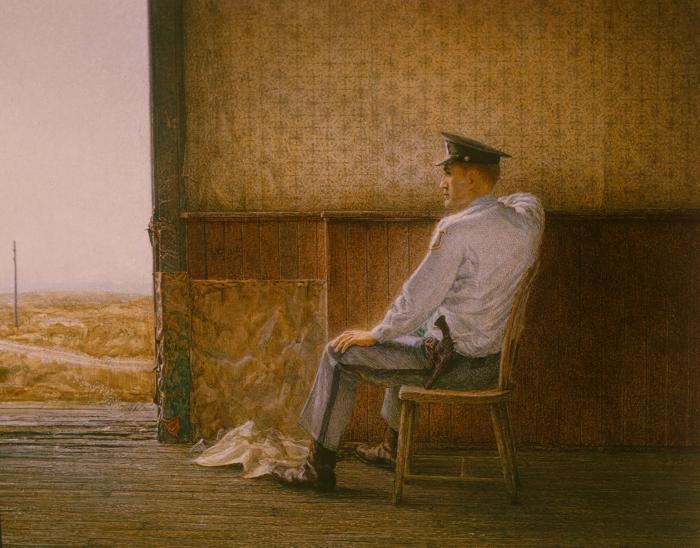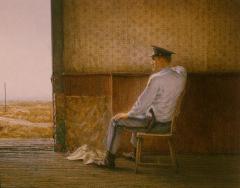During that time Armand joined a few other local artists of kindred spirits. Founded in 1955 by Carl Forslund, Bill Kubiak, and Armand Merizon, the Grand Valley Artists group was established to reaffirm a focus on realism and naturalism, beauty that was at once classic and timely. Still, there were others in the community who promoted the more modern approaches of expressionism and modernism. According to Carl Forslund, their debates were lively.
Clearly the community was interested in art and eager to foster it. As Forslund recalls they put just a small notice in the Grand Rapids Press inviting artists who were interested in traditional realism to attend a meeting, expecting a small group. The first meeting was held in the Forslund Furniture Store in the glitzy marble-lined Metz Building, which also housed the Hefner Framing Gallery.
Forslund recalls, “We had one big room that had the dining room furniture displays in there, and we had thought maybe twenty or thirty people would show up. Instead I think it was close to 200—and 195 of them smoked, which everybody did then. I had to clean the ash trays after everybody left” (Dornbush/Zandstra Interview with Carl Forslund, 6-14-04).
Right away they started to work on “the concept of Grand Valley Artists, its constitution and bylaws.” Forslund continues, “We did that at Armand’s house on Thomas, and that’s how we started.” As the years and members added up, the Grand Valley Artists would become the oldest and arguably the most engaging art group in Western Michigan.
Forslund continues, “When Grand Valley Artists (GVA) first started, we wanted two things along with our focus on realism. We wanted a place where we could get together as a group, not as an instruction class, but as independent painters. The second thing we wanted was what is called a critique. That’s where an individual work is put up on an easel and everybody expresses their opinions. Now a critique can be very helpful or it can be very devastating, particularly to artists who want to be praised for what they think their work is and not for what should be done, and that is another thing that has continued up to this day.”
The first meetings were held in the historic Pantlind Hotel, but later they moved to the St. Cecelia Music Center and then in early 2000 to a GVA facility at 1345 N. Monroe Avenue. Armand attended the general meetings faithfully and loved the critiques. He was regularly invited to be the featured speaker. In addition, a Saturday afternoon life drawing class was organized at Kendall School of Design, where through the years they hired live models to pose.
Long before they became close friends Carl Forslund recalls his envy when he first saw Armand’s work. “I hate to say it but in the old days I envied the fact that Armand was represented by a fine, fine gallery in Grand Rapids, Hefner’s, and they happened to be in the Metz Building which is now a parking lot, but it was right next to our store on Fulton, and I would go over and look at the paintings. That’s when I first saw his works.”
Forslund’s conclusion? “Somebody knew how to draw, somebody knew how to paint. At the time there was a great deal of abstract expressionism. That was a big thing. Do whatever you want. Paint over your shoulder. Schools were touting a variety of experimental methods. Paint the way you want. Throw buckets of paint at the canvas. It was splashy and undisciplined. And, of course, you didn’t really have to know how to draw. In stark contrast to all of them, Armand knew how to draw.”


